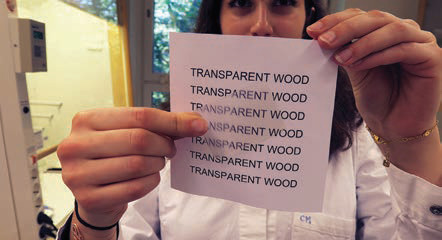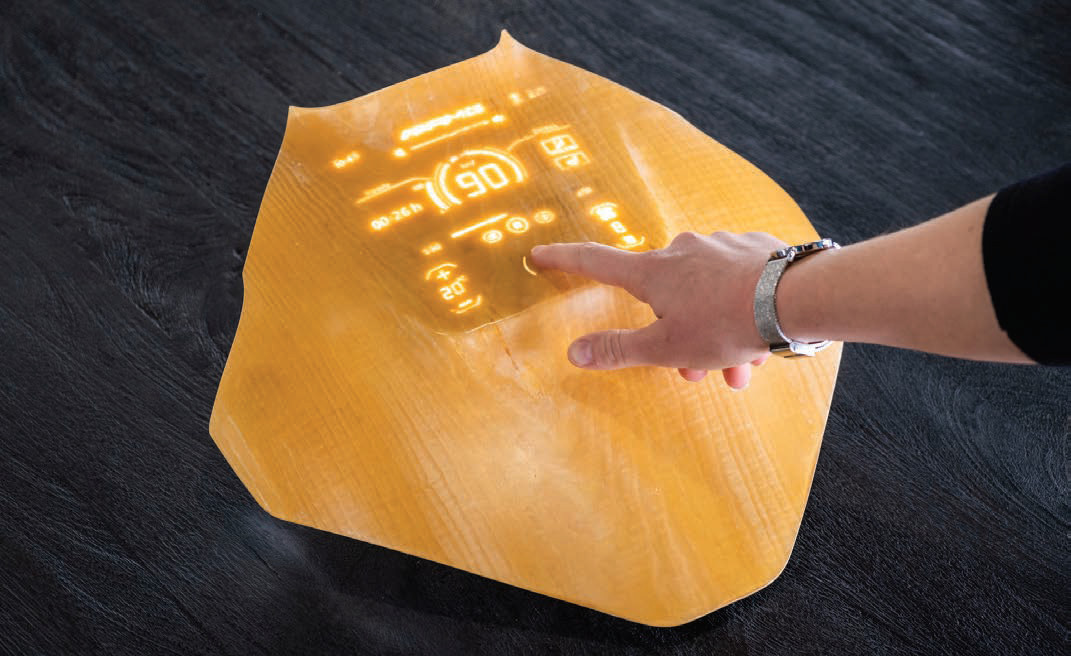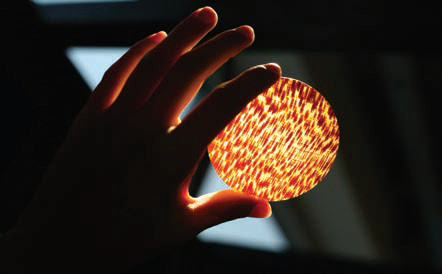Clear vision
27 February 2020Sarah Wild reports on the next generation of modified timber – augmented, transparent wood
When Timothée Boitouzet studied architecture in Japan, where buildings need to survive earthquakes, he realised the next smart material might be one that humans have used for thousands of years – wood.
“In France, we build more with concrete and stone than wood,” he said. ‘When I was exposed to Japanese building culture, I realised how you could build fantastic structures with wood. This material that we considered an old material, without innovation, was actually super smart. This got me excited about wood.”
In 2016, Mr Boitouzet founded a material science company called Woodoo, in Paris, which retrofits timber to give it new properties. His focus is on transforming the construction industry through replacing steel with wood, for example. Unlike other construction materials, such as stone or concrete, wood is a renewable resource, making it an attractive sustainable building material for Mr Boitouzet.
Building more with trees could also help curb the construction industry’s large carbon footprint, which is accelerating climate change. A recent report by the World Green Building Council estimates that 11% of global carbon emissions come from materials and construction processes throughout the building lifecycle. As trees contain carbon, using timber in buildings is a way of storing carbon.
However, timber, can be used for more than just structural support. By selectively extracting wood’s lignin – the substance that makes up its cell walls – and replacing it with a specific type of polymer, it becomes a new material. “(This wood) is weather-proof, more fire resistant, three to five times stronger, and transparent,” said Mr Boitouzet.
The optical properties of the polymer are matched to that of the wood so that light does not bend when it moves through the augmented wood. Instead, it passes through. This transparency opens up a wide range of possibilities.
Augmented
So far, the automotive industry is the sector that has shown the most interest in Mr Boitouzet’s augmented wood.
Currently, through his company and through collaboration with industry partners, he is working on integrating electronics into touch-sensitive wood. The material, which transmits light, will become wooden panels for “tactile dashboards” in cars, Mr Boitouzet said.
Woodoo sees the automotive industry as a gateway to get its products to market, while introducing wood products that are lighter and produce fewer emissions than traditional panels.
Mr Boitouzet is not the only one excited by the possibilities that wood offers. Lars Berglund, a professor in wood and wood composites at the KTH Royal Institute of Technology in Sweden, has discovered that there are many uses for transparent, strong wood.
“It’s a difficult area to be original in because people have worked on wood technology for hundreds of years,” said Prof Berglund, who heads up the WoodNanoTech project. While other research has mainly been trying to address timber’s challenges, such as its reaction to water, he and his team have focused on its other characteristics.
“We have been able to free ourselves from that limitation and look at new possibilities that have not been considered so far,” he said, adding that their focus is on using transparent wood for engineering applications.
Prof Berglund uses wood as a template for nanotechnology by – like Boitouzet – stripping out the lignin, introducing an optically compatible polymer, and adding other technology to broaden its functionality.
The application that excites Prof Berglund the most is embedding quantum dots in wood to create light-emitting diodes (LEDs), because he suspects it could be the application that will allow the team to break into the commercial market.
“The idea is that your ceiling would be a wood panel, and the wood panel would have this LED function, so you can have indoor lighting directly from the ceiling,” he said.
Unlike a point-source light, the transparent wood’s light is diffuse, making it more natural and easy on the eye, he added. Quantum dots are a collection of semiconductor atoms, a few nanometres wide, which fluoresce when exposed to UV light.
These panels are just one of the many applications that WoodNanoTech has devised for transparent wood. The wood may also form the basis for electrochromic windows. These ‘smart windows’, which are painted with a thin layer of polymer, can block out light when electricity is run through them.
Energy
Prof Berglund believes that this nextgeneration wood also has a place in the energy sector.
“We can improve the efficiency [of solar cells] because the scattering of the light [inside the wood] means that the path of the [light] is longer, so you can absorb more energy,” he said.
And using a phase-change material rather than a polymer to replace the lignin transforms wood into an energy storage device. During the day, this infused wood can absorb heat, but at night, when temperatures cool, the phase-change material crystallises, releasing heat.
“We start with the wood, make it loadbearing, and then integrate [nano] technology with other functions,” Prof Berglund said.
The main challenge for new technologies is scalability, and next-generation wood is no exception.
“How do you scale from lab processing, where you have close control over your nanostructure, to something that can be done on an industrial scale?” said Prof Berglund, adding that the institute is looking for commercial partners.
For Woodoo’s Timothée Boitouzet, the fact that the company already has industry partners allows it to increase production. Currently, it produces 5,000m2 of augmented wood per year – and it is aiming for 300,000m2 a year.
Luckily, it is easy to source timber for augmented wood.
There are already many places where they can acquire wood, said Mr Boitouzet, adding that Woodoo uses beech, pine, and poplar, among other species. Meanwhile Prof Berglund’s research team retrofits balsa and is turning its attention to birch.
The next step for Prof Berglund is to make his modified wood more environmentally friendly. One way to do this would be to retain as much of the lignin as possible, instead of discarding it. “If you remove it, you’re adding a chemical step which is going to cost energy and require solvents,” he said. Using more lignin also means retaining more carbon in buildings.
Right now, his team is focusing on using a greener polymer in the materials.
“So far, we have used petroleum-based polymers to impregnate the wood, but we’re working very intensely now to use a biobased polymer,” he said. That would secure next-generation wood’s position as a building material of the future.
 Prof Berglund’s team have used a petroleum-based polymer to replace the lignin in wood, but they are searching for a greener alternative Photo KTH Royal Institute of Technology/David Callahan
Prof Berglund’s team have used a petroleum-based polymer to replace the lignin in wood, but they are searching for a greener alternative Photo KTH Royal Institute of Technology/David Callahan
 Integrating electronics into touch-sensitive wood could pave the way for interactive wooden dashboards in cars Photo: Woodoo
Integrating electronics into touch-sensitive wood could pave the way for interactive wooden dashboards in cars Photo: Woodoo


